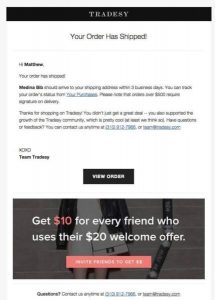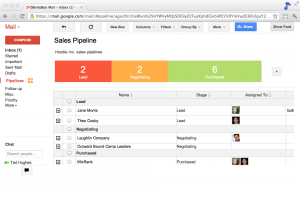
When it comes to digital marketing, organic lead generation is considered the Holy Grail. However, nurturing organic leads is as important as generating them. Not all of your potential consumers are going to buy your product or service based on the first impression alone. You will need to convince them that they should choose your brand and tell them how it will change their lives.
Nearly 80% of new leads never translate into sales. But, companies that excel at lead nurturing can generate 50% more sales-ready leads at a 33% lower cost. Nurtured leads also make 47% larger purchases compared to non-nurtured leads.
Unfortunately, most marketers treat lead nurturing as an afterthought, rendering it useless. In other words, if you start nurturing your freshly generated leads right from the beginning, you will be able to make the most of your marketing efforts. So, how do you go about it?
Here are five tips that will help nurture your organic leads.
1. Create Customer Journey And Educate Your Prospects Accordingly
One of the most crucial steps in nurturing organic leads is educating your prospects based on their requirements. However, the process begins by mapping out your prospect’s journey.
The buyer’s journey is a framework that recognizes different touch points a person experiences, from dealing with your band for the first time until making the purchase. The typical buyer goes through three stages including awareness, consideration, and decision. Consumers face different hurdles at various stages of the journey. In other words, each of these stages requires different pieces of educational content.
A. Awareness
In the early stage of the journey, people are looking for answers, resources, and insight into their problem. So, you should focus on sharing the latest trends, developments, community or user reviews, and industry statistics with them.
B. Consideration
In the middle of the journey, consumers start considering possible solutions to their problem. So, target them with content that shows how your product or service will solve their problem. For example, you can invite them for a webinar or share free “How-to” guides or eBooks with them.
C. Decision
At this stage, they will decide to buy the most suitable product or service. Make sure to share customer success stories, case studies, and product reviews to entice them into buying your offerings.
Use this journey map along with buyer personas to spot both, gaps and opportunities in your marketing strategy. Line up your future content marketing campaigns accordingly. Segmentation of your organic leads will allow you to target your customers and measure your efforts with higher accuracy. However, you will need to use only the crème de la crème of your content to make it happen.
2. Create Content That Your Target Audience Keeps Craving For
Self-centered or sales-y content has no place in digital marketing. While your competitors are mostly busy selling their product or service through content marketing, you should focus on providing more value. Providing value-added content is the best way to nurture your organic leads at any stage of the buyer’s journey.
In 2016, Frontline Education, a K-12 school administrative software provider, used a well-planned content strategy to generate one-third of the company’s sales pipeline. They wanted to focus on educating the leaders in the education industry. So, their content marketing team used a combination of customer interviews, internal subject matter experts, and original industry data from Frontline Research & Learning Institute.
This approach worked, generating 32% of the company’s new leads, while their lead nurturing emails witnessed a 195% increase in click-to-open rate. The content was so informative and educational that prospective clients often replied to their emails thanking Frontline Education. It’s no surprise Frontline Education won the 2017 Content Marketing Award for Best Content Marketing Program presented by the Content Marketing Institute.
One of the best ways to come up with a cracking content creation and marketing strategy is to audit your existing content. You should thoroughly search your website, blog, social media profiles, and lead nurturing emails to understand which content is getting more engagement. You can reuse this content and create fresh content in a similar vein to improve your lead nurturing efforts. You may even consider outsourcing your content creation responsibility or consult a content marketing firm.
3. Create Persona-driven Email Campaigns
Email marketing is perhaps the best way to not only generate new organic leads, but also nurture them. Without personalization, however, your lead nurturing email campaigns will be dead in the water. According to the Litmus 2018 State of Email Survey, boosting email personalization is the number one priority for marketers.
However, it works only if your personalization efforts go beyond just a name. You need to personalize the emails according to your prospect’s behavior. It all boils down to persona-driven content. You can create a buyer persona for each organic lead based on their online behavior, location, season, weather, likes, and dislikes. For example, if a potential consumer shows interest in a particular product (online behavior), you can send them relevant follow-up information such as discounts, offers, and customer reviews.
Talkwalker, a social media analytics company, recently sent this (see below) personalized email. The email urges their prospects to take advantage of the free World Cup LIVE Dashboard ahead of the football World Cup kick-off to create campaigns around content related to football. That’s a great way to personalize email messages as per the trends.
On the other hand, Amazon uses personalized emails to encourage buyers to share product reviews. They also ask users to share their shopping experience and review the product seller. This is one more way to do it.
You can take this strategy to the next level by creating personalized subject lines, preheaders, and headers. Don’t hesitate to include advanced personalization such as dynamic content in your body text and call to action (CTA). However, avoid sending emails too often or at the time they are less likely to be opened.
4. Don’t Rely On One Platform For Lead Nurturing
Don’t get me wrong, email marketing is great, but isn’t enough to nurture your organic leads. You need to personalize your marketing messages on other platforms as well, even if it is your very own website or social media profile.
Using smart or dynamic call-to-action is one way to target different website visitors. According to a recent study, personalized calls-to-action converts 202% better compared to traditional CTA. You can use smart CTAs to greet your website visitors by name or show tailored content based on their location, browsing history, language preferences, and overall buyer persona. Dynamic CTAs allow you to showcase the content mapped to the lead’s stage of the buying cycle.
Zendesk uses the following dynamic CTA to the target website visitors who are contemplating making a purchase, but haven’t reached a decision yet. They ask prospects to view a live product demo. It makes perfect sense to send out this message considering the prospect’s journey stage.
You can also use a dynamic CTA as an on-site message that drives prospects to the right content based on their interest. While browsing a blog post about using Instagram Stories for successful social media campaigns, CoSchedule sent me a pop-up offering 100 free Instagram images. Hard to resist such a tempting offer, right? Interestingly, they also use CTA in a chat box to encourage customers to subscribe to their emailing list.
5. Build Your Lead Nurturing Ecosystem
As you can see, lead nurturing involves various tactics. However, they all focus on two things: listening to the needs of your prospects and providing them with the necessary information or answers. In short, you need to know precisely when, where, and what needs to be delivered, which is possible only if all your tactics work in sync with each other.
A. Set Objectives For Content Creation
A typical lead nurturing system has the following goals –
- Encourage those prospects that have been delaying their purchase to buy the desired product.
- Bring back those leads that have abandoned their carts.
- Remind existing customers to come back for more.
That’s why you need to create a self-sustaining system capable of producing, distributing and analyzing the content generated to achieve these goals.
B. Set A Timeline For Deploying The Content
Whether you are sending emails or push messages, it is better to create a content distribution cycle. For example, sending out 2-3 emails in a typical lead nurturing cycle is a good idea. But, spacing them apart in first, second, and third week respectively is even better. Send them too frequently and users will certainly unsubscribe from your email list.
Parting Words
Organic lead nurturing is a critical aspect of digital marketing. If done right, it will allow you to outperform your competitors, especially the ones that aren’t using this tactic. However, it will take some experimentation to create a functional and efficient lead nurturing policy for your business. Hopefully, these five tips will prove helpful in generating a suitable strategy and cut back on experimentation. If you are still confused, drop your queries in the comments section below. We will be more than happy to help you out.
The post Nurturing Organic Leads: Here’s How to Do It appeared first on Search Engine People Blog.
(95)
Report Post





